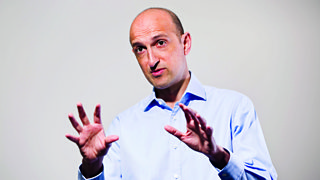What's the secret of making a smash hit pop song?
The name Max Martin might not ring any bells with you, but the songs Baby One More Time, I Kissed a Girl, and I Want it That Way probably do. Max is the songwriter behind them. Or rather, Max is one of the writers behind them. After John Lennon and Paul McCartney, he’s had the most number one hits in the world – an astonishing 22 of them. In Sideways, Matthew Syed explores the ideas that shape our lives. In this episode, he digs down into what is behind Max’s huge song writing success.

Matthew Syed delves into the extraordinary career of the enigmatic pop powerhouse who's one of Sweden's most significant musical exports, in Sideways.
If Max Martin is so prolific, why haven’t we heard of him?
According to John Seabrook, a journalist for The New Yorker who wrote a book about the songwriter, Max is “genuinely shy. He’s very much the guy behind the scenes. And I think he really wants to remain that way, even though it’s almost impossible because he’s had so much success.” The reason for this success? His knack for making a cohesive team.

The Swedish music miracle
Part of Max’s success may be attributed to his Swedish upbringing. Proportionately to its size, Sweden exports more pop hits than any other country in the world, with Swedish songwriters and producers collaborating with artists from all over the world. So what is it about Sweden that makes it so successful in the pop industry?
Dr Ola Johannson, Professor of Geography at the University of Pittsburgh explains that Sweden has a culture of collaboration, which plays into its vibrant music scene. “Swedish organisations beyond the music industry are known to have what we call a ‘flat decision-making structure’ where everybody participates equally, whether you are the boss or not. I think for song-writing, that type of social model turned out to be very useful.” Ola suggests that this approach has its roots in the social democratic project of the 20th Century, which spans far wider than the music industry. “It has reshaped Swedish culture in many different ways. For example, it is customary in Sweden to talk to everybody using the first name, there’s no Mr or Sir – beyond maybe the King.”

The seductiveness of Stockholm
Stockholm itself is partly to thank for the country’s musical success. The city is neither tiny nor massive, with a population of two million including the suburbs. Ola explains why this is handy: “The downtown core is walkable and they [producers] were all within walking distance or a quick cab ride between each other. That kind of space turned out to be very suitable. It occupied a very good spot in being useful as a social space for the music industry.”
Traditionally, songs are written by one person, or one person takes on the music and another the lyrics. Cheiron’s approach was far more collaborative.
A collision of worlds
In the 1990s, Max formed a hair metal group called It’s Alive, which secured a recording contract at Cheiron Studios with producer Denniz PoP. While the album they produced flopped, Max had made an impression on Denniz after playing him some of his demos. As a result, Max got a call asking him to partner with the producer.
As his name suggests, Denniz had a background in pop music, which was at odds with Max’s roots in rock. Denniz also loved American funk, which influenced his input, whereas Max would contribute chord progressions with a distinctly European feel to them. Despite – or rather – because of their differences, the pair gelled brilliantly, as shown by their success with a struggling American boy band…
Denniz asked Max to work with a group who were having difficulty breaking into the mainstream. His influence worked, and they soared to huge success, with their third album selling over 30 million copies. That band was Backstreet Boys.
Teamwork makes the dream work
Cheiron worked differently from other studios. Traditionally, songs are written by one person, or one person takes on the music and another the lyrics. Cheiron’s approach was far more collaborative. Jörgen Elofsson, who worked alongside Denniz and Max explains: “We weren’t really alone doing anything. We sat a lot and we critiqued each other a lot. There was this vibe of helping each other, which was kind of unique at that time, I think.” Even the set up of the studios was conducive to collaboration. Jörgen describes how colleagues would constantly run into one another. To reach the vocal room, for instance, they’d have to pass a studio, which they’d often pop into en route so that they could listen to each other’s work.

Baby One More Time
How composing Britney Spears's best-selling debut album ever was a collaborative effort.
This approach is typified by the way, in 1998, the studios worked with an emerging teenage artist from the Deep South – Britney Spears. Her success speaks for itself – her album featuring Baby One More Time became the bestselling debut in history.
Teams are three to four times more likely to write a hit paper or produce a hit patent than individuals.Prof. Brian Uzzi
But there are many people to thank for its success. Max worked on Baby One More Time with co-writer Remi Yacoub. Songwriters Per Magnussen, Jurgen Eloffson and David Kreuger all worked on the album too. Per, an original team member at Cheiron, describes the creative process: “When we did (You Drive me) Crazy by Britney Spears with me, David and Jurgen had the basic song. We had a chorus and then Max got into studio, listened, and didn’t really like the verse and said: ‘Why don’t you do it like this instead?’ Then he just sang what became the new verse.”
What’s the science behind collaboration when it comes to writing a smash hit?
To understand how collaboration is successful in the music industry, we can look to success in the area of scientific research. Brian Uzzi, a professor at Kellog School of Management set out to uncover what was behind the success of the most impactful research. He explains: “We went to one of the largest bodies of knowledge available, called the Web of Science. We basically measured the citations of every single paper that had ever been written. We coded it as being written by a team or by a solo author, and then we compared the level of impact that teams were having relative to solo authors.”
Brian and his co-workers did this with over seven million US patent findings and discovered that those with the highest number of citations (and therefore the biggest impact) were written collaboratively by teams. Whereas once scientists were more solitary beings, from 1950 onwards they started to work systematically in teams. These teams grew in size, and now, says Brian, “teams are three to four times more likely to write a hit paper or produce a hit patent than individuals.”
Stuck in a creative rut
By 1998, Denniz and Max’s partnership came to a tragic end when Denniz died of stomach cancer, aged just 32. Max, eight years his junior, was left to take over as director of the studios. But the Swedish Music Magic could only help Max so far. In the year 2000, two years after Denniz’s death, Cheiron Studios shut its doors. Max’s music had lost its appeal, and for four years he didn’t write a single US Top Ten hit.
At the Polar Prize ceremony in 2016, Max describes an epiphany he had: “Maybe I’m the one that’s wrong. Maybe I’m the one who needs to start listening to some other music and get out, you know?” That’s what he did. Max travelled to New York, where he linked up with the producer Dr. Luke. Together, they wrote a hit song performed by Kelly Clarkson, and Max got his mojo back. He’s since collaborated on hits performed by Katy Perry, Taylor Swift, Ariana Grande, The Weeknd and Ed Sheeran – to name just a few.

Ideas having sex
How did collaborating elsewhere lead Max back to success in song writing? It is perhaps thanks to a phenomenon called "recombinant innovation". Recombinant innovation, or "conceptual blending", involves combining two distinct technologies to create something brand new.
Matt Ridley, author of "How Innovation Works" explains how recombination is vital to both human innovation and genetic evolution. “Most evolution takes place by the rearrangement of genes, so as to put them in new combinations, rather than mutations in genes themselves.”
It all comes back to sex. “Sexual reproduction shuffles the genes so that you end up with combinations of genes you didn’t have before. So I call the equivalent process in human innovation ‘ideas having sex.’ Two people have developed different technologies, you bring them together and you think, ‘Oh my goodness, we can make a third technology out of this.’” The wheelie suitcase is a great example of this: Wheels + Suitcase = A brand-new, back-ache-saving invention.
Max’s new work melded diverse musical concepts, and he collaborated with the likes of Johan "Shellback" Schuster of Sweden’s hardcore and death metal scene; Bonnie McKee, a classically trained pianist and choral singer; and Rami Yacoub, a Swedish songwriter with Palestinian heritage. Max’s musical talent is undeniable, but it is his knack for collaboration that is the secret to his success.
As he said in 2016: “I think every creative person has an ego. But you really have no choice but to let other people's talent touch you and inspire you, because if you don't, then what's the point?” Teamwork really does make the dream work.
Download and listen to Sideways: Top of the Pops.


-
![]()
Sideways
Best-selling author Matthew Syed explores the ideas that shape our lives with stories of seeing the world differently.
-
![]()
Watch: The real story of Stockholm syndrome
Matthew Syed looks at how the behaviour of hostages at a 1973 bank robbery gave rise to a new concept. (����ý Ideas)
-
![]()
What makes Britney Spears so iconic?
Journalists Sarah Carson and Owen Myers tell us what makes her so special and a gay icon.
-
![]()
Profile: Taylor Swift
Becky Milligan profiles the multi award-winning, platinum selling American singer-songwriter.




